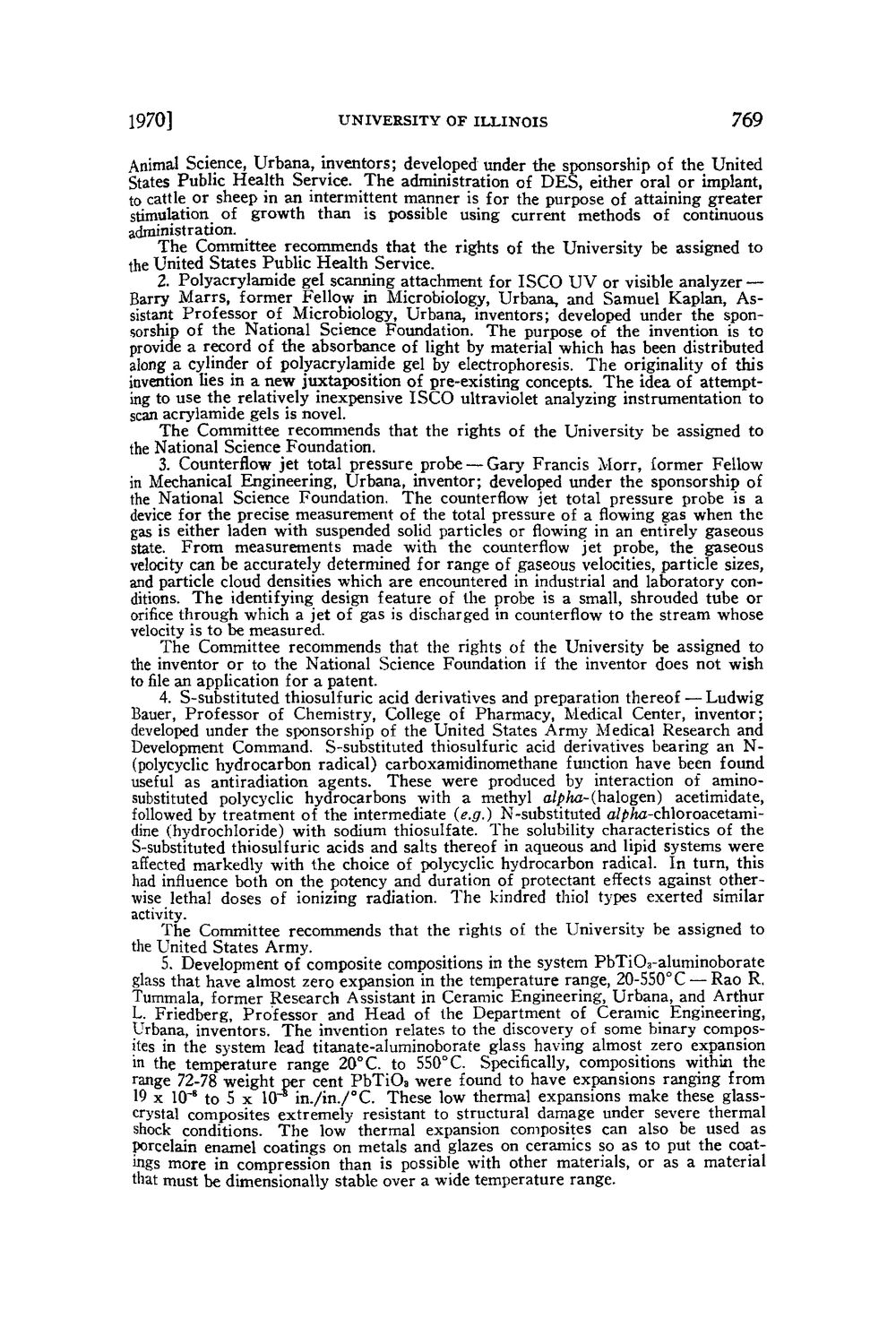| |
| |
Caption: Board of Trustees Minutes - 1970
This is a reduced-resolution page image for fast online browsing.

EXTRACTED TEXT FROM PAGE:
1970] UNIVERSITY OF ILLINOIS 769 Animal Science, Urbana, inventors; developed under the sponsorship of the United States Public Health Service. The administration of D E S , either oral or implant, to cattle or sheep in an intermittent manner is for the purpose of attaining greater stimulation of growth than is possible using current methods of continuous administration. The Committee recommends that the rights of the University be assigned to the United States Public Health Service. 2. Polyacrylamide gel scanning attachment for I SCO U V or visible analyzer — Barry Marrs, former Fellow in Microbiology, Urbana, and Samuel Kaplan, Assistant Professor of Microbiology, Urbana, inventors; developed under the sponsorship of the National Science Foundation. The purpose of the invention is to provide a record of the absorbance of light by material which has been distributed along a cylinder of polyacrylamide gel by electrophoresis. The originality of this invention lies in a new juxtaposition of pre-existing concepts. The idea of attempting to use the relatively inexpensive I SCO ultraviolet analyzing instrumentation to scan acrylamide gels is novel. The Committee recommends that the rights of the University be assigned to the National Science Foundation. 3. Counterflow jet total pressure probe — Gary Francis Morr, former Fellow in Mechanical Engineering, Urbana, inventor; developed under the sponsorship of the National Science Foundation. The counterflow jet total pressure probe is a device for the precise measurement of the total pressure of a flowing gas when the gas is either laden with suspended solid particles or flowing in an entirely gaseous state. From measurements made with the counterflow jet probe, the gaseous velocity can be accurately determined for range of gaseous velocities, particle sizes, and particle cloud densities which are encountered in industrial and laboratory conditions. T h e identifying design feature of the probe is a small, shrouded tube or orifice through which a jet of gas is discharged in counterflow to the stream whose velocity is to be measured. The Committee recommends that the rights of the University be assigned to the inventor or to the National Science Foundation if the inventor does not wish to file an application for a patent. 4. S-substituted thiosulfuric acid derivatives and preparation thereof — Ludwig Bauer, Professor of Chemistry, College of Pharmacy, Medical Center, inventor; developed under the sponsorship of the United States Army Medical Research and Development Command. S-substituted thiosulfuric acid derivatives bearing an N(polycyclic hydrocarbon radical) carboxamidinomethane function have been found useful as antiradiation agents. These were produced by interaction of aminosubstituted polycyclic hydrocarbons with a methyl alpha- (halogen) acetimidate, followed by treatment of the intermediate (e.g.) N-substituted a/£/w-chloroacetamidine (hydrochloride) with sodium thiosulfate. The solubility characteristics of the S-substituted thiosulfuric acids and salts thereof in aqueous and lipid systems were affected markedly with the choice of polycyclic hydrocarbon radical. In turn, this had influence both on the potency and duration of protectant effects against otherwise lethal doses of ionizing radiation. The kindred thiol types exerted similar activity. The Committee recommends that the rights of the University be assigned to the United States Army. 5. Development of composite compositions in the system PbTi0 3 -aluminoborate glass that have almost zero expansion in the temperature range, 20-550° C — Rao R. Tummala, former Research Assistant in Ceramic Engineering, Urbana, and Arthur L. Friedberg, Professor and Head of the Department of Ceramic Engineering, Urbana, inventors. The invention relates to the discovery of some binary composites in the system lead titanate-aluminoborate glass having almost zero expansion in the temperature range 20° C. to 550° C. Specifically, compositions within the range 72-78 weight per cent PbTiOa were found to have expansions ranging from 19 x 10"" to 5 x 10 in./in./°C. These low thermal expansions make these glasscrystal composites extremely resistant to structural damage under severe thermal shock conditions. The low thermal expansion composites can also be used as porcelain enamel coatings on metals and glazes on ceramics so as to put the coatings more in compression than is possible with other materials, or as a material that must be dimensionally stable over a wide temperature range.
| |